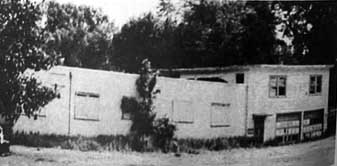Plantation Night Club
Old White Bear Avenue at Cottage Park Road
White Bear Lake
Many thanks to Sara Markoe Hanson of the White Bear Lake Area Historical Society for sharing the Society’s Plantation materials with me. This turned out to be a fun project, especially with the gangster element! Two important resources used were:
Looking Back at White Bear Lake: A Pictorial History of the White Bear Lake Area, by Cynthia E. Vadnais, (provided by the WBLAHS) and
John Dillinger Slept Here: A Crooks’ Tour of Crime and Corruption in St. Paul, 1920-1936, by Paul Maccabee, Minnesota Historical Society Press, 1995
WHERE AND HOW TO GET THERE, 1930
The Plantation Night Club opened in 1930 on the shores of White Bear Lake. The current location is described as Old White Bear Avenue at Cottage Park Road.
This early ad gives some pre-freeway directions from the City:
From Minneapolis: E. Hennepin to Highway 1
From St. Paul: Highway 1 to Auto Club
1926
RAMALEY’S PAVILION
The story starts with the Ramaley family. J.D. Ramaley owned Ramley’s Pavilion at White Bear at the turn of the 20th Century.
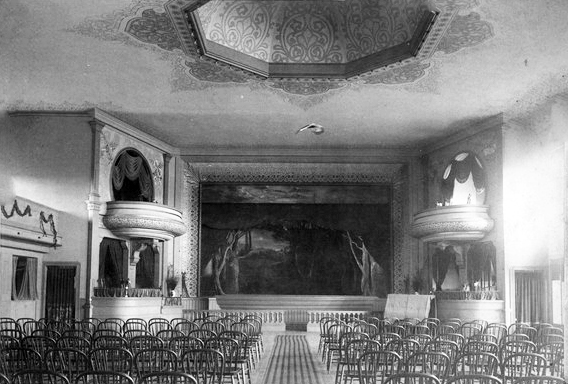
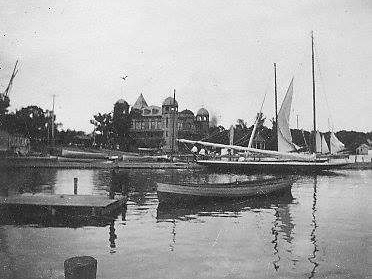
RAMALEY’S WINTER GARDEN
In 1925, J.D.’s son J.E. (Gene) Ramaley moved Ramaley’s Boat Works to Lake Minnetonka, and converted the old boat house at White Bear into a dance hall.
Later in 1925, Gene Rameley demolished the boat house and erected Ramley’s Winter Garden. The building could seat 700 and had parking for 300 cars. It cost $50,000 to build.
An article in the White Bear Press described the Winter Garden as:
a fairlylike stucco structure in Spanish style, adorned with flags and a blaze of light outside, and inside containing a spacious dancing pavilion, the fruition of a beautiful dream in which nothing even to the smallest detail has been forgotten or overlooked. The terra cotta color scheme is heightened by myriads of var-colored [sic] lights, baskets of flowers along the wall, and graceful hanging chandeliers, while the slightly arched ceiling suggest the “grand salon” of a gigantic Atlantic liner.
The popular Land of Lakes Orchestra from Wildwood [a nearby amusement park] discourses sweet music from an aerial platform accompanied by beautiful electric lighting effects. The spacious dancing floor is now as smooth as the first coat of glare ice that forms annually on the lake about Thanksgiving day. (Vadnais)
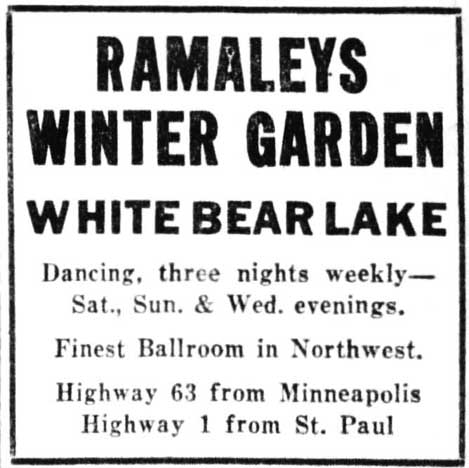
1927
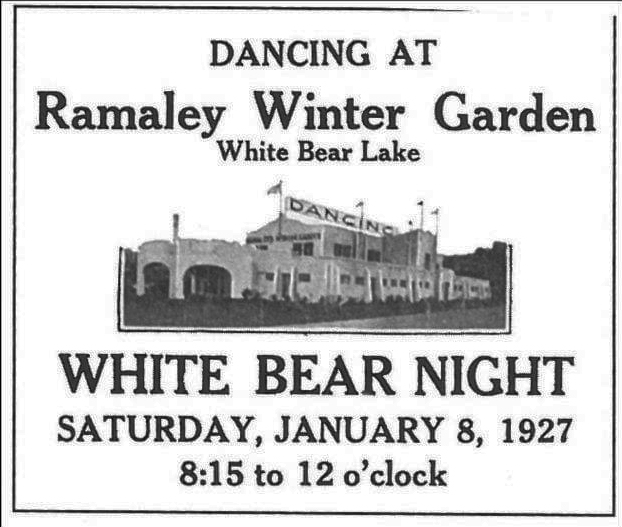
During 1927 the business was leased to two separate parties.
WMBE
The first was T.E. Barbeau, who had radio station, WMBE, hooked up so that the dance music could be broadcast. At this time only Saturday night dances were held. In 1928, the station was removed and donated to White Bear High School. (Vadnais)
An article dated May 28, 1928, indicates that this station was “the White Bear High School station,” and was cancelled by the Federal Radio Commission. The cancelled stations were in small cities or had small ranges, and were in the interest of “clearing up the radio tangle.” (Minneapolis Star)
THE NEW PERSHING INN
The New Pershing Inn opened in the building on December 3, 1927 [Thanksgiving Day, 1927]. There had been a Pershing Inn at approximately present-day Highways 100 and 394 that burned down in 1926, but other than the name, there is no indication that there is any connection. The owners were different; the New Pershing Inn in White Bear was leased by a Mr. Mendelsohn from Minneapolis.
An article, unfortunately with no date or name of newspaper, announced the change:
Winter Garden to Change to Cafe.
A deal has been consummated whereby the Ramaley Winter Garden management passes into other hands and the name is to be changed In fact the garden is to be converted into a cafe with dancing and various amusement features.
The new proprietor is Mr. H. Mendelsohn, of Minneapolis, who took charge Monday.
“It is my intention,” said Mr. Mendelsohn,” “to conduct a ten-piece orchestra, singers, dancers, and other features of entertainment…..”
Continuing, Mr. Mendelsohn stated that the name of the garden has been changed to the “New Pershing Inn.” There will be dancing Saturday night of this week, but there will be no cafe service; neither will there will be any dancing during the coming week until Thanksgiving night when the grand opening will be held. At this time, and every evening thereafter, except Monday nights, the cafe will be open and the full program carried out.
“The pavillion will be for rent on Monday nights,” said Mr. Mendelsohn, “or let on a percentage basis for charitable purposes. All other nights will be regular cafe nights. It is our intention to purchase everything we can right here in White Bear and to boost all we can for the city, and trust we will have the good will and support of the people of this city.”
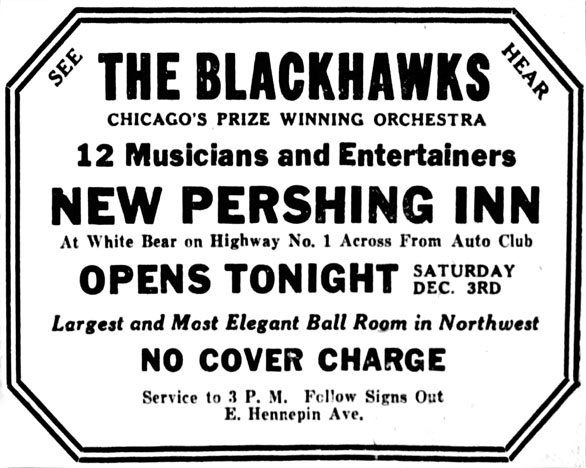
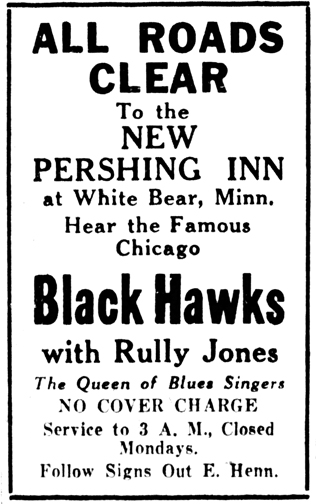
Ads for the New Pershing Inn only appeared in Minneapolis papers during the month of December 1927.
Ramaley was once again the manager before the end of the year. (Vadnais)
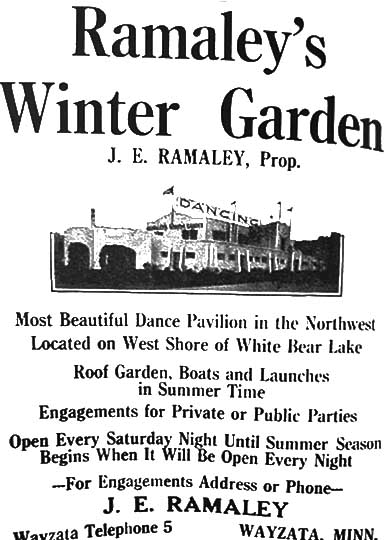
1928
WHITE BEAR CASTLE
In 1928, there were two ads in the Minneapolis papers for the White Bear Castle. Larry Johnson was the manager. The ad below cites Walt Anderson and His Original Golden Pheasant Cafe Band. The Golden Pheasant was a Downtown Minneapolis Chinese restaurant with a checkered reputation. In 1927, the band was called Walt Anderson and His Hoodlums…
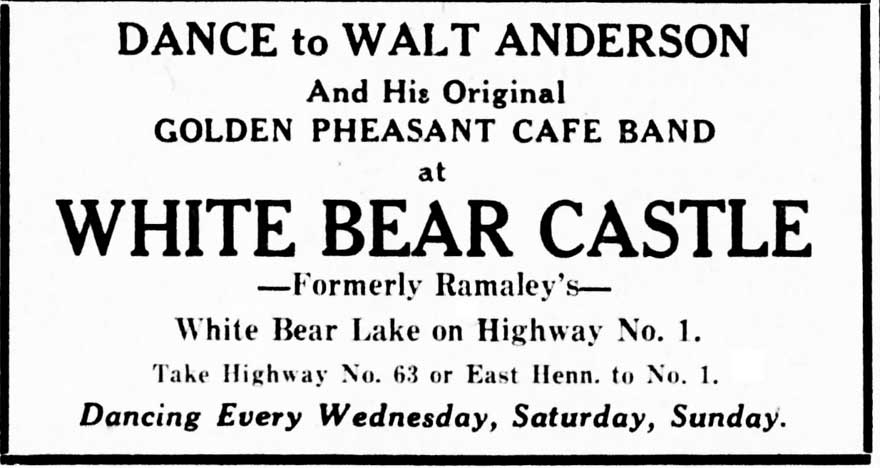
The White Bear Press published at least two other ads for the White Bear Castle in 1928 – dates unknown. (Vadnais)
1929
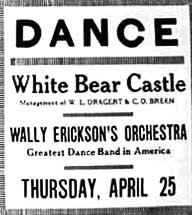
On May 8, 1929, Ramaley advertised to rent the building for “dance, dine.” (Minneapolis Tribune)
1930
THE PLANTATION NITE CLUB
The Plantation “Formerly” (sic) opened on Wednesday, July 2, 1930, at 9 o’clock, announced an article in some unidentified newspaper (presumably the White Bear Press). The first night was an invitation-only premier party. Manager Ben Harris would be the proprietor during the entire run of the club.
$10,000 had been spent to make the place look like a plantation:
Beautiful trees spread their branches, forming a canopy, and creating a bower of foliage. The check room is a splendid replica of an old shed, in one corner of the plantation. (White Bear Press)
From information below about the gangsters and their activities, one would speculate that part of that $10,000 went into building a casino with a separate entrance that could be guarded and monitored.
KSTP radio was connected and the music broadcast for half an hour each evening, five days a week. (Vadnais)
Below is the photo of the club that accompanied the initial article. Keep an eye on the sign on top of the building. It did not originally have the scaffolding that it had later on.
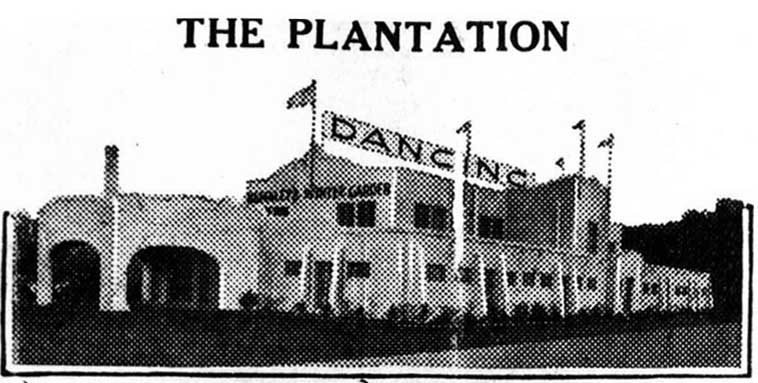
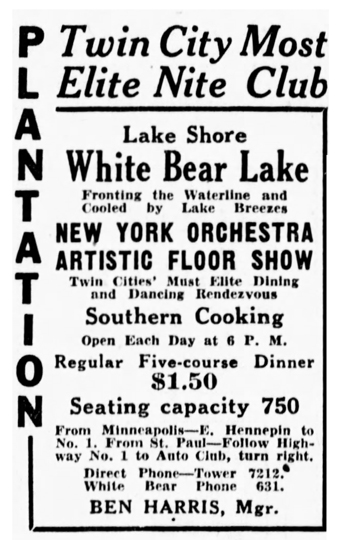
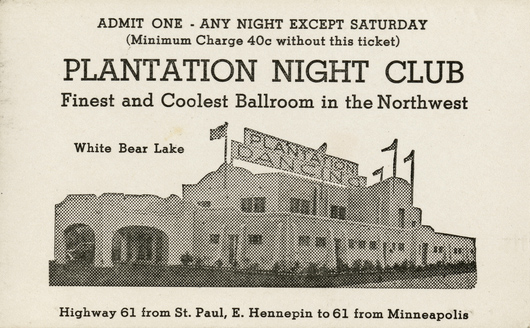
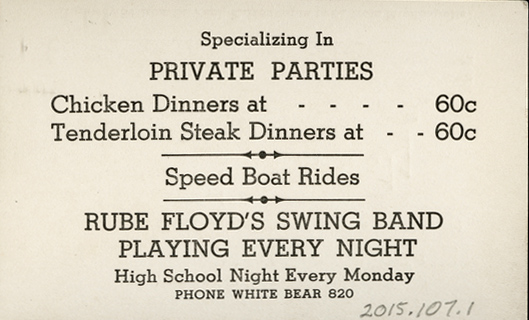
1931
The 1931 season opened on June 16.
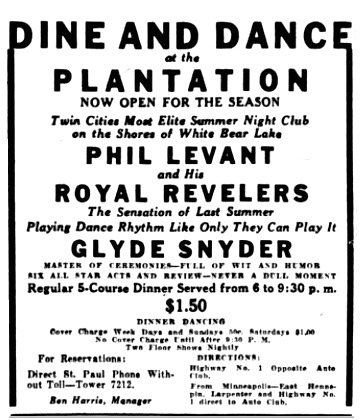
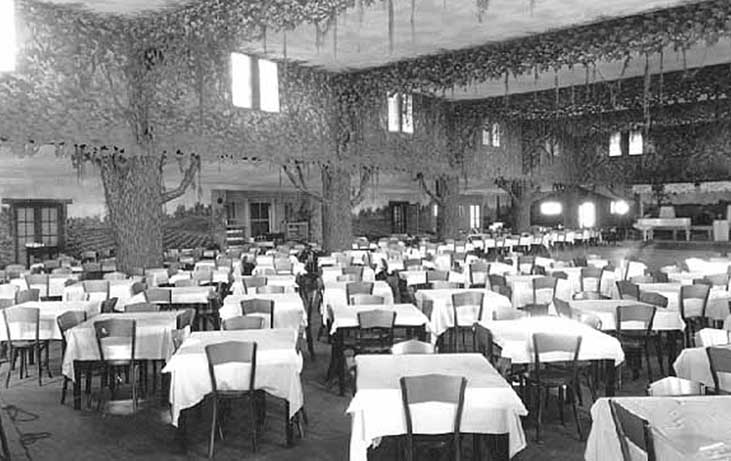
GANGSTERS AT THE PLANTATION
The Plantation was run by Ben Harris, a Minneapolis gambling figure that the FBI claimed “was directly connected with the Barker-Karpis gang, and with practically all of the well-known crooks in Minneapolis and St. Paul during the prohibition days.” Harris told the FBI that he actually had a partner, John Lane, owner of the Boulevards of Paris night club.
Robert “Frisco Dutch” Steinhardt acted as a bouncer and gambling consultant at the casino he and Bob Hamilton opened. Dutch was a friend of the Barker-Karpis and Keating-Holden gangs, had participated in the famous Willmar bank robbery, and had been arrested 18 times for various petty crimes. In 1932 Steinhardt ran the gambling at the Plantation for 60 percent of the proceeds.
Other patrons during the summers of 1931 and 1932 were local fixer Jack Peifer and bootlegger Morris Roisner, bank robbers Jimmy Keating and Tommy olden, and Capone gunman Fred Goetz. Despite reported sightings, Capone himself preferred to vacation in Wisconsin. Frank Nash, a visiting gangster from Oklahoma in 1931, reportedly won $6,000 in one night of gambling. But all was not rosy for Nash – he could not go swimming in the beautiful White Bear Lake because of his toupee.
Strength in numbers made local and even national gangsters of the era comfortable in White Bear Lake, renting cottages for the summer and using the Plantation for their headquarters. This infuriated FBI Chief J. Edgar Hoover. “With ready money and confidence in their power,” said an official FBI summary, the gangs “relaxed vigilance and indulged in riotous nightlife” in White Bear Lake. (Maccabee, pages 96 – 98)
It has been said that armed guards with Tommy guns stood outside the entrance to the gambling casino. (Vadnais)
Oh, and about liquor, Prohibition lasted between 1920 and 1933. No liquor was served during that time, but the club did provide set-ups and people brought their own bootlegged hooch of choice. (Vadnais)
1932
The 1932 season opened on June 15.
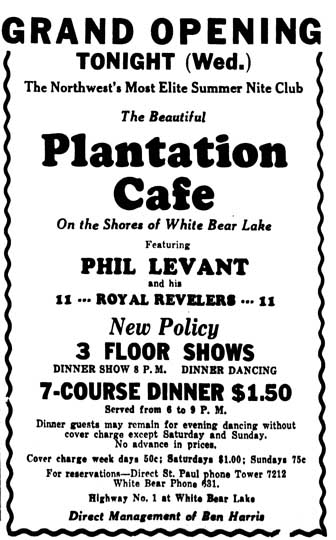
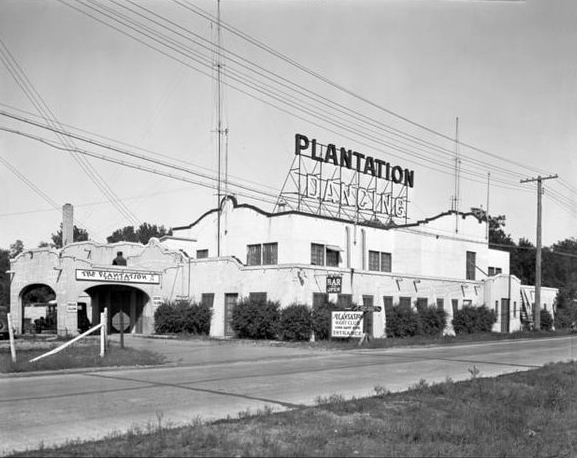
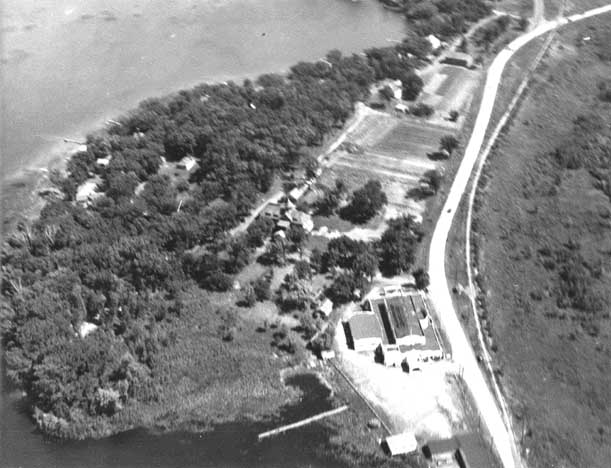
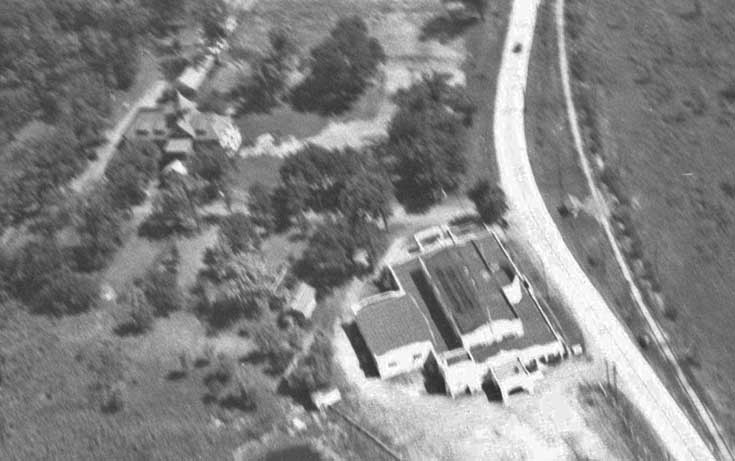
1933
Beer became legal on April 7, 1933, and the harder stuff according to local law. Bootlegging became less profitable, and the Depression put a dent in people’s spending cash.
Opening day for the 1933 season was June 7, and an article (presumably from the White Bear Press) dated June 2, 1933, described the amount of work the building needed after standing empty for nine months. Repairs were needed to the roof, floor, and ceiling – the latter decorated as the sky. Real southern moss was hung from the trees and a cooling system was added.
Joe (Coon) Sanders was the big act on the bill, said to be the first in America to entertain on the radio. Each night there would be three floor shows with stars such as singers Rick and Snyder; dance team the Texas Redheads; and acrobatic dancer Bebe Belmore. Patrons were served a seven-course dinner, and there was no cover charge.
Below is the ad from opening day, 1933.
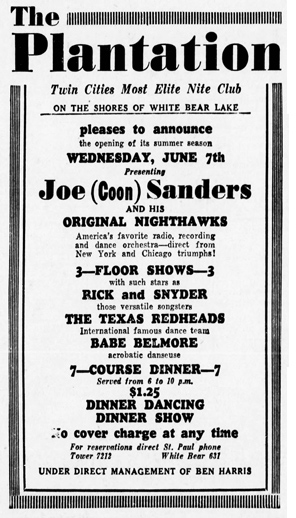
A follow-up article dated June 9, 1933, reports that over 800 people came to the opening of the Plantation, with patrons coming as far as Stillwater, Hudson, Northfield, St. Cloud, and Fargo, Ben Harris’s home town. A storm turned off the lights for about 20 minutes, but candles made for “a quite pleasing effect.” All of the acts were well received, the article reported, and the orchestra members and artists “are making a scramble for cottages here for the summer.” “Red” Hyland was again the house manager. Little “George” – the colored door man – who has heretofore been a red bird, has changed his habit to blue – a blue-bird for happiness, seems if. (presumably White Bear Press)
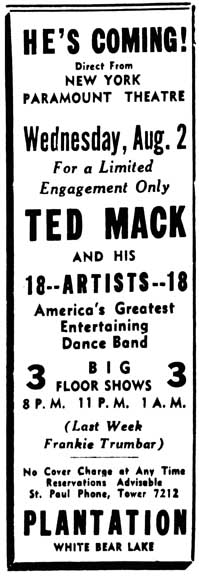
Ben Harris closed the Plantation at the end of the 1933 season. He said, “In 1930 and ’31 I did well, but the Depression hit everybody so hard they couldn’t keep up their patronage. 1932 was hard but 1933 was worse.” (Vadnais)
1934
On March 30, 1934, the Ramsey County sheriffs were apparently trying to clean up the area. On that day they held warrants for “Bennie Harris,” described as former proprietor of the Plantation Night Club, for maintaining gambling devices. (Minneapolis Tribune, March 31, 1934) Harris pled guilty to running a roulette wheel and was given 90 days in the workhouse. (Minneapolis Star, April 6, 1934) The sentence was later cut to 30 days and he was allowed to serve it in the county jail instead of the workhouse, all for his convenience since he ran a liquor store by the St. Paul courthouse at the time. (Minneapolis Star, April 21, 1934) In August 1934, Harris went on to manage the new 620 Club in Downtown Minneapolis and many other bars.
1935
In 1935, Ramaley decided to reopen the Plantation. The bill of fare was a wholesome, all-family-members-allowed barn dance at a bargain admission price of 35 cents. The club wass to be open six nights a week with four different orchestras performing each week. WTCN was the radio station that broadcast the dance music. (Vadnais)
On May 17, 1935, the WCCO Barndance performed at the Plantation. 25 performers came to present a live radio show. (White Bear Press ad courtesy Vadnais)
1937
The Plantation opened on June 16, 1937. “Under Same Management.” (White Bear Press ad courtesy Vadnais)
1939
Management was apparently renting the building out to groups for dances, as evidenced by an article in the St. Paul Recorder that advertised a “big cabaret dance” on October 9, 1939, sponsored by the Cameo Social Club. Rube Floyd and his swing band would provide the music. The public was invited. The St. Paul Recorder was the City’s weekly newspaper for the black community. Social clubs would often find venues to hold dances, since most clubs in town were not integrated. The term “cabaret dance” is seen quite often, but I don’t know what it entails. (St. Paul Recorder, October 6, 1939)
1941
Another big dance advertised in the St. Paul Recorder took place on Monday, July 21, 1941. Les Hite and his orchestra presented stars such as Oscar Bradley, the world’s fasted drummer; Qudy Martin, ace tenor and clarinetist; Smokey Joe, second only to Jimmie Rushing; and Hite’s famous Swinging Glee Club. An added attraction was that the winners of the Negro Open Golf Tourney were to receive their prizes at the affair. Also, the article said that “this will be the First public dance the Twin Cities dancing public has ever had at the beautiful Plantation Nite Club.” (Notwithstanding the 1939 event.) Contacts for making reservations were Vernon Barksdale or L. Garrett. (St. Paul Recorder, July 18, 1941)
A follow-up article in the next week’s Recorder called the Hite dance “one of the most orderly and largest dance crowds of the year” and named Levi Garrett as the promoter. Most of the rest of the article was kind of gossip column, naming popular party-goers. (St. Paul Recorder, July 25, 1941)
PLANTATION BALLROOM?
The ad below calls the place the Plantation Ballroom. Did it change it’s name? It’s image, perhaps?
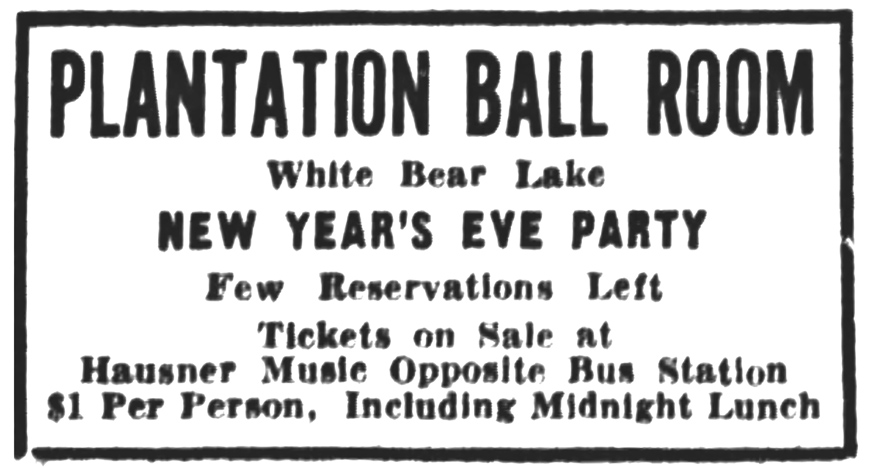
1942
Expectations may have been to continue the operation of the Plantation into 1942, as evidenced by the ad below, opening the building at the end of May.
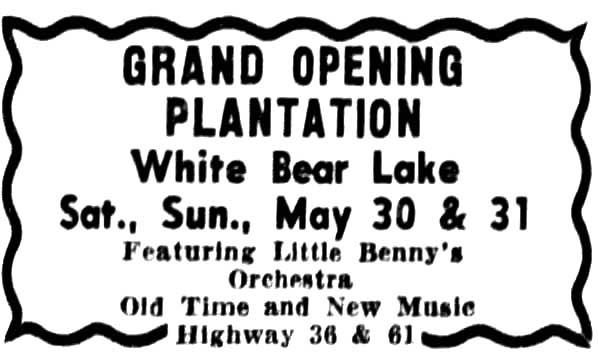
A dance was held by the Onyx Club at the Plantation Nite Club on May 29, 1942, according to Inquisitive Sal (Helen M. Scott), Social reporter of the St. Paul Recorder. The Omega Psi Phi Fraternity was holding their spring prom the same night, and Sal suspected that after the prom, many of the attendees would dash out to the Plantation (and the wonderfully-named Stumble Inn) for after parties. (St. Paul Recorder, May 29, 1942)
The next issue of the Recorder reported that a severe storm spoiled the party, and it was announced that it would be rescheduled for Friday, June 12. Soldiers in uniform would be admitted for free. Rook Ganz’ “fine cabaret” will entertain the patrons. (St. Paul Recorder, June 5, 1942)
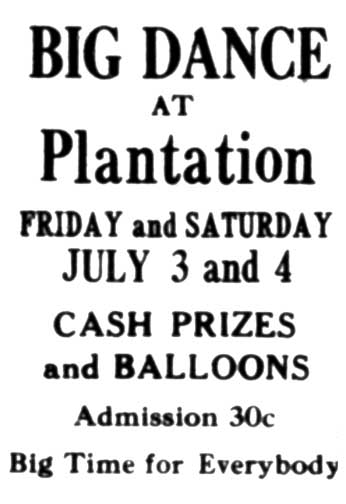
It has been reported that the building went dark during World War II. The few dances in 1942 above may have been the last uses of the building as a dance hall.
1946
THE PLANTATION PLAYHOUSE
In 1946, three former service men, Kenneth and David Raskin, and Allen Livers wanted to transform the old building into what would become the Plantation Playhouse. This was at just the time that the Aulger Brothers Tent Shows, active since 1899, went out of business. Aulger sold his equipment, including 400 auditorium seats, for their new theater. (Minneapolis Star-Journal, Virginia Safford column, May 20, 1946)
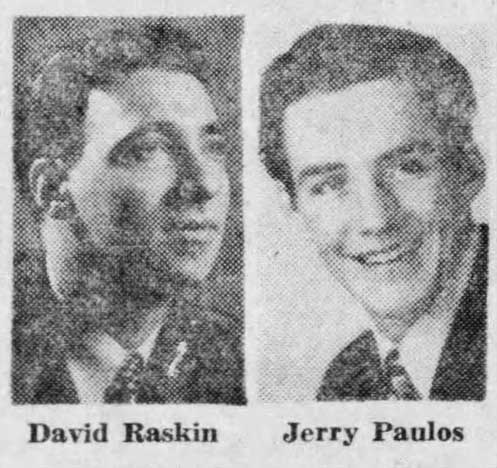
The first play presented was “The Hasty Heart,” starting June 19, 1946.
Below is an early program.
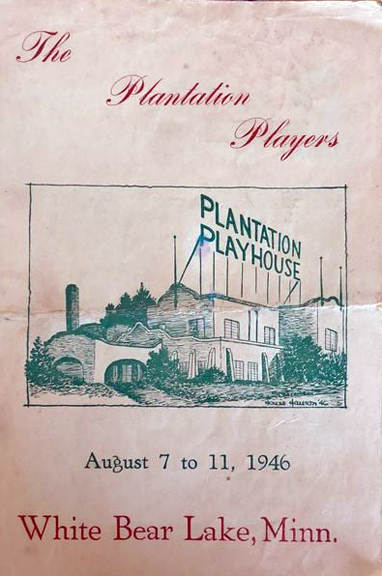
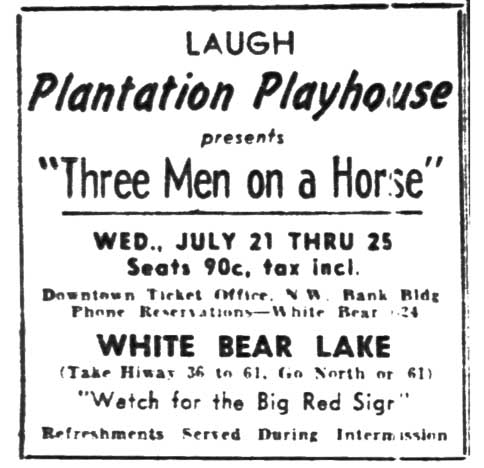
Plays were performed by University of Minnesota students on shoestring budgets. The playhouse lasted for at least three seasons.
1951
The building stood vacant in 1949. In 1950, Arthur Allen purchased the building and razed most of the main structure. The building was remodeled into a building shaped like a boat. The Plantation Boat Livery & Drive-In opened for business on May 12, 1951. Allen had purchased boats for hire from Amundson Boat Works, and with his family successfully operated the business until about 1959. (Vadnais)
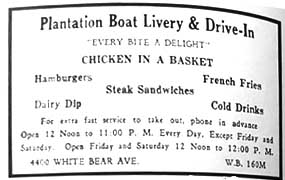
END OF THE PLANTATION
The City of White Bear Lake purchased what was left of the building on May 31, 1974. It was finally razed in June 1974. In its place is Lion’s Club Park, with the address of 4410 Lake Ave. So.
